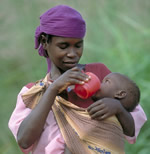More than 1 million infants – and an estimated 70,000 adolescent mothers – die each year in the developing world because young girls are marrying and having children before they are physically ready for parenthood, according to the fifth annual State of the World’s Mothers report issued today by Save the Children, a leading U.S.-based global independent humanitarian organization.
The report includes an Early Motherhood Risk Ranking that identifies 50 countries where motherhood is most devastating for young girls and their babies. Nine of the 10 highest-risk countries are in sub-Saharan Africa. Niger, Liberia and Mali top the list. Other countries with high-risk scores outside of Africa include: Afghanistan, Bangladesh, Guatemala, Haiti, Nepal, Nicaragua and Yemen.

In the 10 highest risk countries, according to the report, more than 1 in 6 teenage girls aged 15 to 19 give birth each year and nearly 1 in 7 babies born to these teenagers die before age 1. The rankings are based on marriage and birth rates among teenage girls in each country as well as infant mortality rates for children born to teenage mothers.
Going beyond the numbers, the report also offers dramatic first-hand accounts from child mothers themselves about the trials of early motherhood. One mother recalls getting married at 7, having sex at 9 and becoming a widow at 12. Many child mothers say they never had the opportunity to be children themselves.
“Childbirth can be a dance with death for young girls and their babies,” said Charles MacCormack, president and CEO of Save the Children, noting that complications from pregnancy and childbirth are the leading killers of teenage girls in the developing world. “Girls are marrying and having children before they are emotionally and physically ready. Often they don’t have a choice. Girls must be valued. Alternatives to early marriage and motherhood must be made available if young girls are to survive and thrive.”

“Access to education is key,” MacCormack said. “Research shows that girls who receive an education are less likely to have babies at a young age. Even mothers with only a basic education have healthier pregnancies, safer deliveries and healthier babies because they are more likely to seek health care services for themselves and their children. Educated mothers also are more likely to send their children – including girls – to school, and to use contraception to space their births.”
Save the Children is calling on the administration and the U.S. Congress to support increased funding for global basic education, child survival, maternal health and family planning programs in developing countries and to expand support for in-school and after-school literacy programs in the United States, particularly in the most underserved rural areas of America.
There are an estimated 115 million school-aged children worldwide who are not in school, and 60 percent of them are girls, MacCormack noted.
Among the report’s other major findings:
• Each year 1 in every 10 births worldwide is to a mother who is still herself a child.
• Girls in their teens in poor countries are twice as likely to die from pregnancy- and childbirth- related causes compared with older women. Girls 14 and under face even greater risks.
• Children born to children are more likely to be delivered prematurely and at low birth weight and are more likely to die in the first month of life.
• Young mothers also face enormous health risks: Obstructed labor is common and results in newborn deaths and death or disabilities for the mother. Research shows that young mothers and their babies also are at greater risk of contracting HIV/AIDS.
• The United States is not immune to the problem. Birth rates for adolescent girls in the U.S. are higher than in any other industrialized country. In fact, in some remote rural communities, adolescent birth rates are higher than in many developing countries.
• Globally, the minimum-age-for-marriage laws must be improved and enforced.
The full text of the 5th annual State of the World’s Mothers report is available as .pdf-File on the Internet at:
http://www.savethechildren.org/mothers/report_2004/images/pdf/SOWM_2004_final.pdf
In addition to its special focus on the dangers of early motherhood, the report also includes Save the Children’s fifth annual Mothers’ Index that identifies the best – and worst – countries to be a mother through a comprehensive look at the status of mothers’ well-being in 119 countries as it relates to their health, education and political status. For the fifth year in a row, Scandinavian countries dominate the upper tier of the rankings with Sweden, Denmark and Finland making up this year’s top three. The United States ranks 10th; Niger is in last place.


